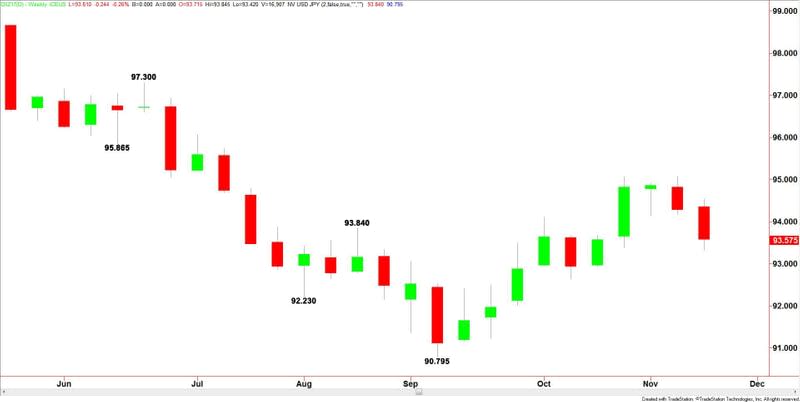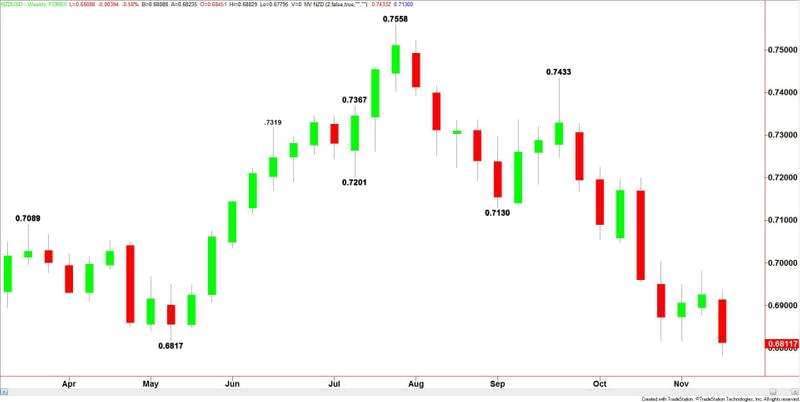Dollar Crushes Aussie, Kiwi, but Loses Ground Against Yen
It was a strange week in the Forex markets last week. The U.S. Dollar Index fell sharply, but the price action was deceptive unless you’re aware of the weightings of the index. Since the Euro makes up about 57% of the index, it exerted the most pressure. The Japanese Yen and the British Pound also weighed on the greenback.
December U.S. Dollar Index futures settled at 93.575, down 0.703 or -0.75%.
Despite the overall weak theme in the dollar, it did manage to post solid gains against the Australian and New Zealand Dollars.
Tax reform concerns were the primary catalyst driving the dollar lower against the Euro, Yen and British Pound. Weak commodity prices and the narrowing of the interest rate differential between U.S. government debt and Australian and New Zealand government debt weighed on the Aussie and the Kiwi.

U.S. Dollar
December U.S. Dollar Index futures trended lower most of the week, but the biggest down move for the week occurred on Tuesday, November 14. On this date, the Euro rose to a 2 ½ week high against the U.S. dollar while posting its largest percentage gain in more than two months, after data showed Germany’s economy shifted into a higher gear in the third quarter.
Germany’s seasonally adjusted gross domestic product (GDP) rose by 0.8 percent on the quarter, compared with an estimate of 0.6 percent.
In the U.S., government reports showed an unexpected rise in producer inflation. U.S. consumer prices barely rose in October as the boost to gasoline prices from hurricane-related disruptions to Gulf Coast oil refineries were unwound but rising rents and healthcare costs pointed to a gradual buildup of underlying inflation.
Despite the tame consumer inflation data, investors felt that it was enough to solidify a Fed interest rate hike in December.
Additionally, the House of Representatives approved a broad package of tax cuts and a Senate panel advanced its own version of the tax legislation sought by senior lawmakers and President Donald Trump. The differences between the House version of tax reform and the Senate’s is the source of concern driving U.S. Treasuries lower, as well as the U.S. Dollar and U.S. equity markets. Investors feel that the process to find middle ground between the two tax overhaul plans may extend into 2018.

AUD/USD and NZD/USD
The Australian and New Zealand Dollar’s fell sharply last week on concerns over Chinese demand for raw materials. Both currencies were pressured by disappointing data on Chinese retail sales and industrial production.
The AUD/USD settled at .7564, down 0.0092 or -1.20% and the NZD/USD closed the week at .6812, down 0.0114 or -1.64%.

The Aussie was also pressured by a disappointing labor report. The Employment Change came in at 3.7K, below the 17.8K estimate. The Unemployment rate, however, dropped to 5.4%.
The Australian Wage Price Index also came in below expectations at 0.5%. Traders were looking for an increase of 0.7%.
This article was originally posted on FX Empire
More From FXEMPIRE:
USD/CAD Price forecast for the week of November 20, 2017, Technical Analysis
Major US Indices, Forecast for The Week of November 20, 2017, Technical Analysis
Price of Gold Fundamental Weekly Forecast – Tax Reform Uncertainty Short-Term Bullish
Natural Gas Price Fundamental Weekly Forecast – Sideways to Lower Until the Next Cold Blast

 Yahoo Finance
Yahoo Finance 